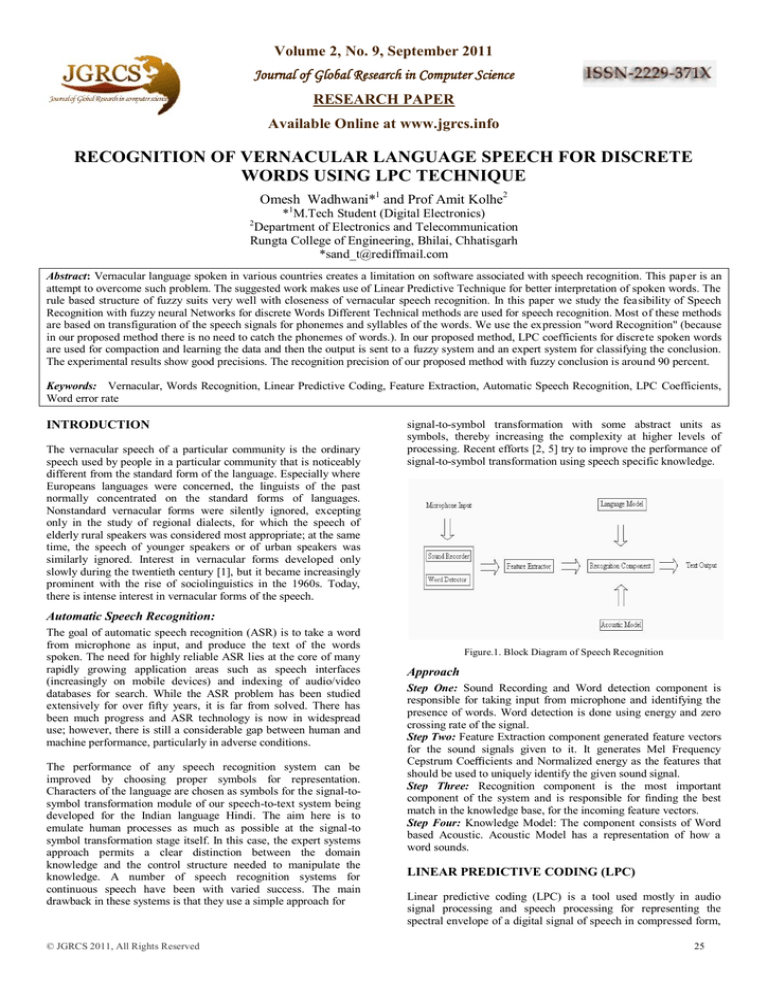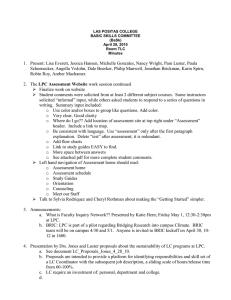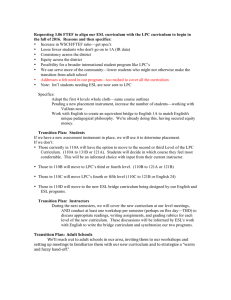
Volume 2, No. 9, September 2011
Journal of Global Research in Computer Science
RESEARCH PAPER
Available Online at www.jgrcs.info
RECOGNITION OF VERNACULAR LANGUAGE SPEECH FOR DISCRETE
WORDS USING LPC TECHNIQUE
Omesh Wadhwani*1 and Prof Amit Kolhe2
*1M.Tech Student (Digital Electronics)
Department of Electronics and Telecommunication
Rungta College of Engineering, Bhilai, Chhatisgarh
*sand_t@rediffmail.com
2
Abstract: Vernacular language spoken in various countries creates a limitation on software associated with speech recognition. This pap er is an
attempt to overcome such problem. The suggested work makes use of Linear Predictive Technique for better interpretation of spoken words. The
rule based structure of fuzzy suits very well with closeness of vernacular speech recognition. In this paper we study the feasibility of Speech
Recognition with fuzzy neural Networks for discrete Words Different Technical methods are used for speech recognition. Most of these methods
are based on transfiguration of the speech signals for phonemes and syllables of the words. We use the expression "word Recognition" (because
in our proposed method there is no need to catch the phonemes of words.). In our proposed method, LPC coefficients for discrete spoken words
are used for compaction and learning the data and then the output is sent to a fuzzy system and an expert system for classifying the conclusion.
The experimental results show good precisions. The recognition precision of our proposed method with fuzzy conclusion is around 90 percent.
Keywords: Vernacular, Words Recognition, Linear Predictive Coding, Feature Extraction, Automatic Speech Recognition, LPC Coefficients,
Word error rate
INTRODUCTION
The vernacular speech of a particular community is the ordinary
speech used by people in a particular community that is noticeably
different from the standard form of the language. Especially where
Europeans languages were concerned, the linguists of the past
normally concentrated on the standard forms of languages.
Nonstandard vernacular forms were silently ignored, excepting
only in the study of regional dialects, for which the speech of
elderly rural speakers was considered most appropriate; at the same
time, the speech of younger speakers or of urban speakers was
similarly ignored. Interest in vernacular forms developed only
slowly during the twentieth century [1], but it became increasingly
prominent with the rise of sociolinguistics in the 1960s. Today,
there is intense interest in vernacular forms of the speech.
signal-to-symbol transformation with some abstract units as
symbols, thereby increasing the complexity at higher levels of
processing. Recent efforts [2, 5] try to improve the performance of
signal-to-symbol transformation using speech specific knowledge.
Automatic Speech Recognition:
The goal of automatic speech recognition (ASR) is to take a word
from microphone as input, and produce the text of the words
spoken. The need for highly reliable ASR lies at the core of many
rapidly growing application areas such as speech interfaces
(increasingly on mobile devices) and indexing of audio/video
databases for search. While the ASR problem has been studied
extensively for over fifty years, it is far from solved. There has
been much progress and ASR technology is now in widespread
use; however, there is still a considerable gap between human and
machine performance, particularly in adverse conditions.
The performance of any speech recognition system can be
improved by choosing proper symbols for representation.
Characters of the language are chosen as symbols for the signal-tosymbol transformation module of our speech-to-text system being
developed for the Indian language Hindi. The aim here is to
emulate human processes as much as possible at the signal-to
symbol transformation stage itself. In this case, the expert systems
approach permits a clear distinction between the domain
knowledge and the control structure needed to manipulate the
knowledge. A number of speech recognition systems for
continuous speech have been with varied success. The main
drawback in these systems is that they use a simple approach for
© JGRCS 2011, All Rights Reserved
Figure.1. Block Diagram of Speech Recognition
Approach
Step One: Sound Recording and Word detection component is
responsible for taking input from microphone and identifying the
presence of words. Word detection is done using energy and zero
crossing rate of the signal.
Step Two: Feature Extraction component generated feature vectors
for the sound signals given to it. It generates Mel Frequency
Cepstrum Coefficients and Normalized energy as the features that
should be used to uniquely identify the given sound signal.
Step Three: Recognition component is the most important
component of the system and is responsible for finding the best
match in the knowledge base, for the incoming feature vectors.
Step Four: Knowledge Model: The component consists of Word
based Acoustic. Acoustic Model has a representation of how a
word sounds.
LINEAR PREDICTIVE CODING (LPC)
Linear predictive coding (LPC) is a tool used mostly in audio
signal processing and speech processing for representing the
spectral envelope of a digital signal of speech in compressed form,
25
Omesh Wadhwani et al, Journal of Global Research in Computer Science,2 (9), September 2011, 25-27
using the information of a linear predictive model. It is one of the
most powerful speech analysis techniques, and one of the most
useful methods for encoding good quality speech at a low bit rate
and provides extremely accurate estimates of speech parameters.
LPC analyzes the speech signal by estimating the formants,
removing their effects from the speech signal, and estimating the
intensity and frequency of the remaining buzz. The process of
removing the formants is called inverse filtering, and the remaining
signal is called the residue. The numbers which describe the
formants and the residue can be stored or transmitted somewhere
else. LPC synthesizes the speech signal by reversing the process:
use the residue to create a source signal, use the formants to create
a filter (which represents the tube), and run the source through the
filter, resulting in speech. Because speech signals vary with time,
this process is done on short chunks of the speech signal, which are
called frames. Usually 30 to 50 frames per second give intelligible
speech with good compression.
Figure.2: Block Diagram of an LPC Vocoder
It has two key components: analysis or encoding and synthesis or
decoding [2]. The analysis part of LPC involves examining the
speech signal and breaking it down into segments or blocks. Each
segment is than examined further to find the answers to several key
questions:
a. Is the segment voiced or unvoiced?
b. What is the pitch of the segment?
c. What parameters are needed to build a filter that models
the vocal tract for the current segment?
All vocoders, including LPC vocoders, have four main attributes:
bit rate, delay, complexity, quality. Any voice coder, regardless of
the algorithm it uses, will have to make tradeoffs between these
attributes.
The first attribute of vocoders, the bit rate, is used to determine the
degree of compression that a vocoder achieves. Uncompressed
speech is usually transmitted at 64 kb/s using 8 bits/sample and a
rate of 8kHz for sampling. Any bit rate below 64 kb/s is
considered compression. The linear predictive coder transmits
speech at a bit rate of 2.4 kb/s, an excellent rate of compression.
Delay is another important attribute for vocoders that are involved
with the transmission of an encoded speech signal. Vocoders which
are involved with the storage of the compressed speech, as opposed
to transmission, are not as concern with delay. The general delay
standard for transmitted speech conversations is that any delay that
is greater than 300 ms is considered unacceptable. The third
attribute of voice coders is the complexity of the algorithm used.
The complexity affects both the cost and the power of the vocoder.
Figure.3: Physical Model of Human.
The basic problem of the LPC system is to determine the formants
from the speech signal. The basic solution is a difference equation,
which expresses each sample of the signal as a linear combination
of previous samples. Such an equation is called a linear predictor,
which is why this is called Linear Predictive Coding. The
coefficients of the difference equation (the prediction coefficients)
characterize the formants, so the LPC system needs to estimate
these coefficients. The estimate is done by minimizing the meansquare error between the predicted signal and the actual signal.
EXPERIMENTAL RESULTS AND OBSERVATIONS
MATLAB software has various inbuilt functions to implement
audio functions and coefficient evaluation. Spoken words of
speaker were stored in a bank and their LPC coefficients were
determined along with energy and zero crossover detection as well
[3]. Later the words were spoken by another speaker whose
phonemes and accent were sent to fuzzy analyzer for correct
interpretation in intelligent way using fuzzy approach discussed
above. Expert system was tested on 120 utterances in English
spoken by two male speakers. It was observed that with just two
parameters (total energy and first linear prediction coefficient)
along with their fuzzy thresholds, spoken words were identified
with more than 90% accuracy.es
Linear predictive coding because of its high compression rate is
very complex and involves executing millions of instructions per
second. The final attribute of vocoders is quality. Quality is a
subjective attribute and it depends on how the speech sounds to a
given listener.
FEATURE EXTRACTION OF SPOKEN WORDS
USING LPC
s
Figure 4: Wave Plot for word „omesh‟
Feature Extraction refers to the process of conversion of sound
signal to a form suitable for the following stages to use. Feature
extraction may include extracting parameters such as amplitude of
the signal, energy of frequencies, etc
Linear prediction is a good tool for analysis of speech signals.
Linear prediction models the human vocal tract as an infinite
impulse response (IIR) system that produces the speech signal. For
vowel sounds and other voiced regions of speech, which have a
resonant structure and high degree of similarity overtime shifts that
are multiples of their pitch period, this modeling produces an
efficient representation of the sound. Figure 2 shows how the
resonant structure of a vowel could be captured by an IIR system.
Figure.5: Energy plot for spoken word “omesh” in vernacular language
© JGRCS 2011, All Rights Reserved
26
Omesh Wadhwani et al, Journal of Global Research in Computer Science,2 (9), September 2011, 25-27
[6] Asim Shahzad, Romana Shahzadi, Farhan Aadil “Design and
software implementation of Efficient speech recognizer”.
International Journal of Electrical & Computer Sciences
IJECS-IJENS Vol. 10.
[7] R. Rodman, Computer Speech Technology. Artech House,
Inc. 1999, Norwood, MA 02062.
[8] C. H. Lee; F. K. Soong; K. Paliwal “An Overview of Speaker
Recognition Technology”. Automatic Speech and Speaker
Recognition: Advanced Topics.
Kluwer Academic
Publishers, 1996, Norwell, MA.
Figure.6: Zero Crossing plot for spoken word “omesh”in vernacular
language
CONCLUSIONS
Linear Predictive Coding is an analysis/synthesis technique to
lossy speech compression that attempts to model the human
production of sound. Linear Predictive Coding achieves good bit
rate which makes it ideal for secure telephone systems. Secure
telephone systems are more concerned that the content and
meaning of speech, rather than the quality of speech, be preserved.
The trade off for LPC‟s low bit rate is that it does have some
difficulty with certain sounds and it produces speech that sound
synthetic. LPC encoders break up a sound signal into different
segments and then send information on each segment to the
decoder. The encoder send information on whether the segment is
voiced or unvoiced and the pitch period for voiced segment which
is used to create an excitement signal in the decoder. Vernacular
language work is not concluded yet. Hence this paper is light on
such approach for enhancing recognition power of intelligent
techniques along with feature extraction. Experimental results also
confirm the same.
ACKNOWLEDGMENT
The Authors place on record their grateful thanks to the authorities
of Rungta College of Engineering for providing all the facilities for
accomplishing this paper.
REFERENCES
[1] M. Forsberg. 2003. Why Speech Recognition is Difficult.
Chalmers University of Technology.
[2] L. R. Rabiner and R. W. Schafer, Digital Speech Processing.
Prentice-Hall, 1978.
[3] J. R. Deller, J. H. L. Hansen, J. G. Proakis. Discrete-time
Processing of Speech Signals. IEEE Press. 1993.
[4] Thiang, Suryo Wijoyo. Speech Recognition using LPC and
Artificial Neural Network for Controlling the movements of
Robot, 2011
[5] N.Uma Maheswari, A.P.Kabilan, R.Venkatesh “Speech
Recognition system based on phonemes using neural
networks”.
JCSNS International Journal of Computer
Science and Network Security, Vol.9 No.7, July 2009
© JGRCS 2011, All Rights Reserved
[9] S. R. Jang, "Neuro Fuzzy Modeling Architectures, Analyses
and Applications". University of California, Berkeley,
Canada, 1992.
[10] P. P. Bonissone, "Adaptive Neural Fuzzy Inference Systems
(ANFIS): Analysis and Applications", technical report, GE
CRD, Schenectady, NY USA, 2002.
[11] P. Eswar, S.K. Gupta, C. Chandra Sekhar, B. Yegnanarayana
and K. Nagamma Reddy, An acoustic phonetic expert for
analysis and processing of continuous speech in Hindi, in
Proc. European Conf. on Speech Technology, Edinburgh,
vol. 1 (1987) 369-372.
[12] J.P. Haton, Knowledge based approach in acoustic phonetic
decoding of speech, in: H. Niemann, M. Lang and G. Serger,
Eds., Recent Advances in Speech Understanding and Dialog
Systems, NATO-ASI Series, vol. 46, (1988) 51-69.
[13] D.H. Klatt, Review of the ARPA speech understanding
project, J. Acoustic. Soc. Amer. 62(6) (1978) 1345-1366.
[14] W.A. Lea, Ed., Trends in Speech Recognition (Prentice Hall,
Englewood Cliffs, N J, 1980).
[15] R.De Mori, A. Giordana, P. Laface and L. Saitta, Parallel
algorithms for syllable recognition in continuous speech,
IEEE Trans. Pattern Analysis" Machine Intelligence.7(1)
(1985). 55-68
[16] D. O'Shaughnessy, Speech Communication - Human and
Machine (Addison-Wesley, Reading, MA, 1987).
[17] B. Yegnanarayana, C.C. Sekhar, G.V.R. Rao, P. Eswar and
M. Prakash, A continuous speech recognition system for
Indian languages, in: Proc. Regional Workshop on Computer
Processing of Asian Languages, Bangkok (1989) 347-356.
SHORT BIODATA OF THE AUTHOR’S
Omesh Wadhwani is a B.E graduate from Kavikulguru
Institute of Technology and Science, Ramtek with the
specialization in Information Technology. He owns more
than two year of Teaching experience.
Currently, He is doing his Master of Technology in Digital
Electronics from Rungta College of Engineering and Technology,
Bhilai. His area of interest are Speech processing and Pattern
Recognition, Image Processing, Database Management systems
and Artificial Intelligence.
27


